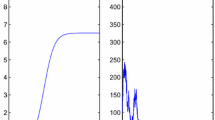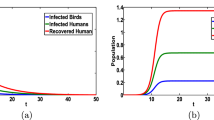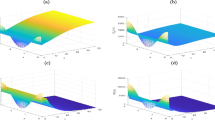Abstract
After the outbreak of the first avian influenza A virus (H5N1) in Hong Kong in 1997, another avian influenza A virus (H7N9) crossed the species barrier in mainland China in 2013 and 2014 and caused more than 400 human cases with a death rate of nearly 40 %. In this paper, we take account of the incubation periods of avian influenza A virus and construct a bird-to-human transmission model with different time delays in the avian and human populations combining the survival probability of the infective avian and human populations at the latent time. By analyzing the dynamical behavior of the model, we obtain a threshold value for the prevalence of avian influenza and investigate local and global asymptotical stability of equilibria of the system.




Similar content being viewed by others
References
Agusto FB (2013) Optimal isolation control strategies and cost-effectiveness analysis of a two-strain avian influenza. BioSystems 113:155–164
Alexander DJ (2007) An overview of the epidemiology of avian influenza. Vaccine 25:5637–5644
Anderson RM, May RM (1991) Infectious diseases of humans: dynamics and control. Oxford University Press, Oxford
Bao C, Cui L, Zhou M, Hong L, Wang H et al (2013) Live-animal markets and influenza A (H7N9) virus infection. N Engl J Med 368:2337–2339
Beretta E, Takeuchi Y (1995) Global stability of an SIR model with time delays. J Math Biol 33:250–260
Beretta E, Hara T, Ma W, Takeuchi Y (2001) Global asymptotical stability of an SIR epidemic model with distributed time delay. Nonlinear Anal 47:4107–4115
Bourouiba L, Gourley SA, Liu R, Wu J (2011) The interaction of migratory birds and domestic poultry and its role in sustaining avian influenza. SIAM J Appl Math 71:487–516
Centers for Disease Control and Prevention (CDC), Types of influenza virus. (August 3, 2011, Retrieved January 15, 2014). http://www.cdc.gov/flu/about/viruses/types.htm
Center for Infectious Disease Research and Policy (CIDRAP) (2013) China reports three H7N9 infections, two fatal. http://www.cidrap.umn.edu/news-perspective/2013/04/china-reports-three-h7n9-infections-two-fatal. Accessed 1 April 1 2013
Chong NS, Tchuenche JM, Smith RJ (2014) A mathematical model of avian influenza with half-saturated incidence. Theory Biosci 133:23–38
Cooke KL, Grossman Z (1982) Discrete delay, distributed delay and stability switches. J Math Anal Appl 86:592–627
Cooke KL, Van Den Driessche P (1996) Analysis of an SEIRS epidemic model with two delays. J Math Biol 35:240–260
Chen Y, Liang W, Yang S, Wu N, Gao H et al (2013) Human infections with the emerging avian influenza A H7N9 virus from wet market poultry: clinical analysis and characterisation of viral genome. Lancet 381:1916–1925
Gao H et al (2013) Clinical findings in 111 cases of influenza A(H7N9) virus infection. N Engl J Med 368:2277–2285
Gourley SA, Liu R (2010) Spatiotemporal distributions of migratory birds: patchy models with delay. SIAM J Appl Dyn Syst 9:589–610
Gumel AB (2009) Global dynamics of a two-strain avian influenza model. Int J Comput Math 86:85–108
Hale JK (1977) Theory of functional differential equations. Springer, Heidelberg
Huang G, Takeuchi Y, Ma W, Wei D (2010) Global stability for delay SIR and SEIR epidemic models with nonlinear incidence rate. Bull Math Biol 72:1192–1207
Iwami S, Takeuchi Y, Liu X (2007) Avian-human influenza epidemic model. Math Biosci 207:1–25
Iwami S, Takeuchi Y, Liu X (2009a) Avian flu pandemic: can we prevent it? J Theor Biol 257:181–190
Iwami S, Takeuchi Y, Liu X, Nakaoka S (2009b) A geographical spread of vaccine-resistance in avian influenza epidemics. J Theor Biol 259:219–228
Jung E, Iwami S, Takeuchi Y, Jo T-C (2009) Optimal control strategy for prevention of avian influenza pandemic. J Theor Biol 260:220–229
Keeling MJ, Rohani P (2008) Modeling infectious diseases in humans and animals. Princeton University Press, Princeton
Li Q, Zhou L, Zhou M, Chen Z, Li F, Wu H, Xiang N, Chen E et al (2014) Epidemiology of human infections with avian influenza A (H7N9) virus in China. N Engl J Med 370:520–532
Liu S, Ruan S, Zhang X (2015) Nonlinear dynamics of avian influenza epidemic models. Math Biosci (submitted)
Lucchetti J, Roy M, Martcheva M (2009) An avian influenza model and its fit to human avian influenza cases. In: Tchuenche M, Mukandavire Z (eds) Advances in disease epidemiology. J. Nova Science Publishers, New York, pp 1–30
Ma X, Wang W (2010) A discrete model of avian influenza with seasonal reproduction and transmission. J Biol Dyn 4:296–314
National Health and Family Planning Commission of China (NHFPC) (2015) Epidemic situation. http://www.nhfpc.gov.cn. Accessed 27 July 2015
Ruan S, Wei J (2003) On the zeros of transcendental functions with applications to stability of delay differential equations with two delays. Dyn Contin Discrete Impulse Syst Ser A Math Anal 10:863–874
Ruan S, Xiao D, Beier JC (2008) On the delayed Ross–Macdonald model for malaria transmission. Bull Math Biol 70:1098–1114
Samanta GP (2010) Permanence and extinction for a nonautonomous avian-human influenza epidemic model with distributed time delay. Math. Comput. Model. 52:1794–1811
Tuncer N, Martcheva M (2013) Modeling seasonality in avian influenza H5N1. J Biol Syst 21:1–30
World Health Organisation (WHO) (2014) Human infection with avian influenza A (H7N9) virus (update). http://www.who.int/csr/don/2014_-02_-24/en/. Accessed 24 Feb 2014
World Health Organization (WHO) (2015) Influenza. http://www.who.int/topics/influenza/en/. Accessed 27 July 2015
World Organisation for Animal Health (OIE) (2013) OIE expert mission finds live bird markets play a key role in poultry and human infections with influenza A (H7N9). Paris. http://www.oie.int/en/for-the-media/press-releases/detail/article/oie-expert-mission-finds-live-bird-markets-play-a-key-role-in-poultry-and-human-infections-with-infl/. Accessed 30 April 2013
Acknowledgments
This work was partially supported by the National Natural Science Foundation (NNSF) of China (No. 11371161 and No. 11228104).
Author information
Authors and Affiliations
Corresponding author
Rights and permissions
About this article
Cite this article
Liu, S., Ruan, S. & Zhang, X. On avian influenza epidemic models with time delay. Theory Biosci. 134, 75–82 (2015). https://doi.org/10.1007/s12064-015-0212-8
Received:
Accepted:
Published:
Issue Date:
DOI: https://doi.org/10.1007/s12064-015-0212-8




